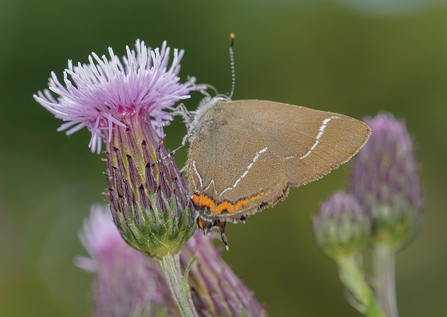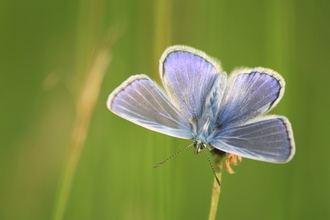It was spotted seemingly arriving in off the sea as it landed on bushes by The Warren watch point; it was definitely a race against time to take some images to confirm the record before it fluttered away, but luckily, it seemed the same butterfly was still present the next morning and viewable for several other visitors while nectaring on bushes nearby. Harry Appleyard, Visitor Engagement Assistant at Spurn, tells us more.
First-ever spotting at Spurn Point
White-letter Hairstreak © Darren Wozencroft 2020
White-letter hairstreak at The Warren, Spurn - 18th July 2024 (c) Harry Appleyard
White-letter hairstreaks get their name from the white tilted “W” on the lower part of their wings, which they always keep closed when perched. Though it is widespread across England, the white-letter hairstreak is a very scarce species, largely confined to localised colonies around elm trees in woodland, parkland and hedgerow habitats - so it was a very unexpected find for our coastal reserve! Their larvae rely exclusively on elm as a food plant, which is sadly why the species suffered a huge crash in its numbers nationally due to dutch elm disease in the 1970s and 80s.
The metallic green hairstreak is a much more familiar species on the Spurn landscape, easy to find on warm, sunny days between mid-April and early June around privet and other bushes along the peninsula. White-letter hairstreaks are much more elusive, with those out in search often needing a lot of patience as they spend a lot of time in the canopy of their favoured trees -but, with a bit of luck, they can sometimes be found basking or feeding closer to ground level on various flowers.

Whiteletter hairstreak (c) John Bridges
As this species can go very easily overlooked, their colonies can also be easily missed - and this is especially true of lonesome dispersing individuals seeking out new territories. This individual spotted at Spurn could be a clue that a small colony is present not far away - or perhaps it is just one from further afield seeking out a new site to call home.
Adult white-letter hairstreaks can be seen from June and into August, so there is still a bit of time to look out for our elusive new visitor at Spurn - and to see if you can spot on at our other reserves further inland.
If you think you have seen one on a Yorkshire Wildlife Trust site, please do try to get pictures and let us know, so we can help monitor and protect both potential colonies and “pit-stops”!

If you’re looking for reserves to enjoy a broad range of our lepidoptera (butterflies, moths and other winged insects) then we have a huge amount to offer. Brockadale near Pontefract, Wharram Quarry and Kiplingcotes in the East Riding, and Brae Pasture up in the Dales are all amazingly beautiful wildflower reserves – with a wealth of fluttering butterflies to enjoy as a result.
Do head out and enjoy the last of the summer sun – and send us some pictures!



